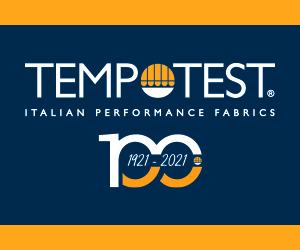Digitally Printed Wall Covering Suppliers Must Note Pigment Printed Upholstery Lies Ahead Software Expert Duncan Ross Says
December 5, 2013
BRUSSELS, Belgium —Suppliers attending the recent MoOD exhibition here have agreed the digital printing evolution has finally arrived in the wall covering and textile industry and promises to accelerate further in the months and years ahead.
For example, Hewlett Packard digital printing systems are having an impact on the wallcovering business after just seven months on the market and fabrics are developing next for the firm according to Terry Raghunath, business development manager, Interior Decoration.
“Designers are embracing digital printing but we are only scratching the surface of this business, especially in fabrics,” says Raghunath who happens to be a Dutch national originally from the island of Curacao—now living in Barcelona, Spain, HP Printing Systems headquarters. Raghunath points to Marburg Wallcoverings and its work with designer Karim Rachid as an example of the success in wall covering. Rachid designs for Marburg covered the HP stand at MoOD.
HP has also worked with Marcus Benesch who has designed wall coverings for Rasch. Traditional manufacturers are finding they can add value to their products through digital printing. However, there are 50,000 small, local digital printers in Europe looking for new business—beyond signs and t-shirts and this may be where the printing business in home furnishings really takes off, Raghunath explains.
He feels that local printers are offering lower priced digital printing at slower speed even though the traditional industry is obsessed with high speed printers. “You can buy 20 slower speed printers versus a faster printer. Sometimes slower speed and higher registration is preferable depending on the design.  Duncan Ross
Duncan Ross
HP is betting on both groups for growing the wall covering business.
“We are still looking for champions of this new technology,” he said during the recently concluded MoOd in Brussels where HP had a huge installation. “We are not there in upholstery yet,” he says. “We feel that right now, wallcovering is the best application of this technology aside from the obvious success we have had in T-shirts and signage.” He also feels the digital printing technology is a good fit for design in window blinds and drapery. “Upholstery is really not our focus,” he adds.
“Digital printing is about personalization and customization. It is a tool for interior architects and designers;” says Asaf Levi, decoration segment Manager for HP. “Every room is different. You can create one off patterns for hospitals, hotels, restaurants and offices with digital printing,” he says. Wall coverings on nonwoven and vinyl backed substrates are the product of choice for digital application, he feels. “You can deliver the design in a few hours from a local printer whereas analog printing might take 15 weeks to execute. There is a savings to be realized on inventory also.” Ultimately, the rapidly reduced cost of digital printing can make it more effective in the future, he says.
Other companies, like Reggiani and MS are more developed in the upholstery arena according to Duncan Ross, Commercial Director of AVA, and a Cad cam specialist in Macclesfield, UK. He sees that a lack of metallic inks for digitally printed designs as a real limitation but this will change over time. He credits digital printing for bringing the print category back into the market. “Many UK retailers and manufacturers have adopted digital technology for printing complicated prints versus traditional wet printing,” he says.
“Digital design is pushing prints back into the market through the elimination of expensive screens and separations.” Ross is adding new features on his software programs to help the designer due this with AVA equipment. “One thing holding digital printing back is that ink particles are clogging up the printer heads with pigment printing. We’re forced to use water based inks for this reason but this can change.”He sees a pigment solution coming out soon and this will accelerate the digitally printed textile industry.
He points to Epson printers which can print heat transfer paper digitally and then this applied to polyester fabric. Miroglio has recently gone 100 percent digital in its printing of transfer paper. Ross said there was much attention paid to wall covering designs by buyers attending INDIGO in Brussels where AVA had a stand this year.
More upholstery fabric manufacturers are being attracted to digitally printed fabrics. Companies like Marteks of Turkey are toying with the idea of purchasing a Reggiani machine for digitally printing upholstery in the future but the price of this machine is at least $500,000, says Kaya Cinoglu, principal.
He has bought 25 double and single width looms for mid to upper upholstery and drapery lines in the past two years and has turned his company around with natural linen looks and more color. He says digitally printed designs are the natural next step for him.
















